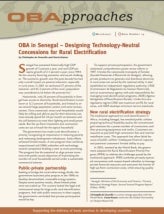Related

Technical Assistance
Senegal: Municipal and Agglomerations Support Program
Technical Assistance
Zambia: Electricity Access
Grant Funding
Ethiopia: Rural Electricity Access Expansion
June 19, 2019 |Press releases
Rural Zambia to Access Electricity in Project Scale-up
September 11, 2009 |Feature Stories
Ethiopia: Dealing with the “Last Mile” Paradox in Rural Electrification
June 21, 2012 |Feature Stories
GPOBA establishes Grid-Based OBA Fund to Provide Electricity to 100,000 Rural Homes in Uganda
OBA in Senegal: Designing Technology-Neutral Concessions for Rural Electrification
Nationwide, only 30 percent of households in Senegal have access to electricity.

Connection Charges and Electricity Access in Sub-Saharan Africa
Sub-Saharan Africa trails other regions in providing access to electricity for poor urban and rural residents.


